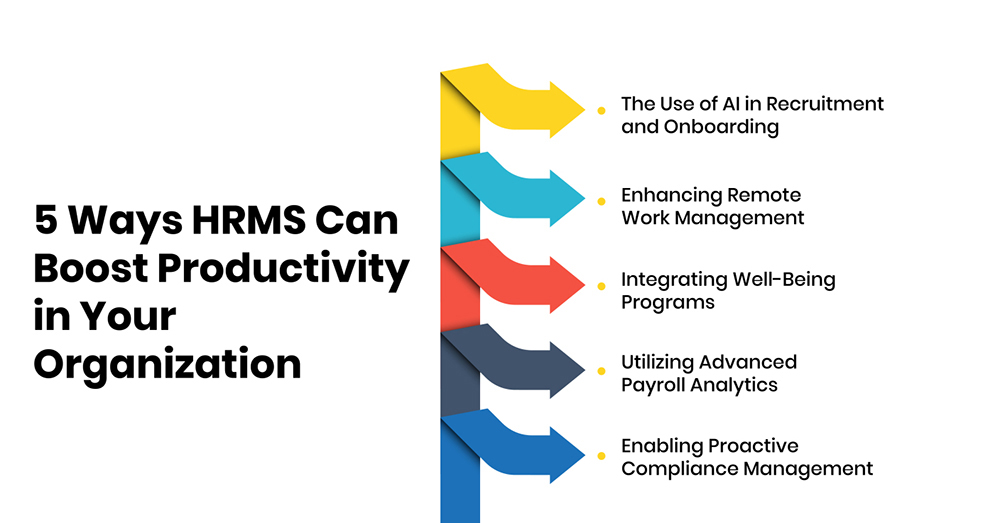
We live in a world where business organizations look forward to achieving higher levels of productivity and efficiency. Among the most useful methodologies that can facilitate the achievement of organizational goals, the Human Resource Management System (HRMS) stands out.
HRMS transforms how your organization addresses HR activities such as the hiring process, new staff orientation, compensation processing, and employee evaluation.
From recruitment and onboarding to payroll and performance management, an HRMS can transform how organizations handle their most valuable assets to their employees.
In this article, we will discuss five major benefits of an HRMS for your organization, thus increasing work efficiency and success.
5 Ways HRMS Can Boost Productivity in Your Organization

1. The Use of AI in Recruitment and Onboarding
-
AI-Powered Candidate Screening: Using AI algorithms, it becomes easier to search for hundreds of resumes within a short span and shortlist candidates who meet specific requirements. This not only saves time but also reduces bias and therefore results in a more efficient and fair method of staffing.
-
Chatbots for Initial Communication: The prospective candidates can ask their questions through the headlights of AI chatbots and get scheduled for interviews or the status of their interviews. This improves the candidate’s experience because of the timely replies and allocation of HR employees’ time to more strategic activities.
-
Virtual Onboarding: Advanced technologies such as Artificial Intelligence can be used to deliver virtual onboarding through learning prescriptions and engaging training lessons. This makes certain that newly hired individuals in the company undergo the same onboarding process regardless of their physical location, hence improving their integration and productivity in the company.
2. Enhancing Remote Work Management
-
Remote work has become the new norm and it has prompted the need for new ideas on how to manage a decentralized team. This means that HRMS can be of extreme importance to workforce productivity and satisfaction, especially for remote workers.
-
Centralized Communication Platforms: Communication platforms like Slack or Microsoft Teams can be connected to the HRMS which will provide the stream for all the necessary data. This ensures that remote employees work as part of the bigger team and feel included in the organization’s working environment.
-
Performance Tracking and Feedback: Working from remote places can be a very hard task to manage employee/worker performance. Around 16% of HR departments actually use agile methodology in their workflows to streamline their process and keep track of performance. With the virtual HR support of employees, organizations can establish m-tools for goals, tracking, real-time feedback, and accountability for remote employees to remain aligned with the organizational goals.
-
Well-Being and Engagement: While using HRMS, the wellness programs, surveys, and engagement activities that are implemented for remote employees to assess and enhance their well-being can be effectively managed. It can likewise keep away from burnout and in this manner, improve general labor productivity.
3. Integrating Well-Being Programs
-
The more that is invested into one’s employees, the more they can be expected to deliver in return, as the health and satisfaction of the workforce can do wonders for performance. HRMS can incorporate wellness initiatives to enhance the organization’s health and employee satisfaction.
-
Personalized Wellness Plans: Wellness plans can be presented by the HRMS, with the requisite information gathered from a health questionnaire. Such plans may involve setting fitness goals, availing counseling services, and receiving recommendations concerning proper nutrition among others, increasing health consciousness among the staff.
-
Usage Analytics: Through the monitoring of participation and benefits of well-being programs, HRMS can shed light on its efficiency and potential drawbacks. This is a strategic method of promoting wellness since the ideas are informed by employee data needs and preferences.
-
Incentive Programs: HRMS can handle the e-rewards that shall be given to the employees as they undertake some health initiative activities. This may help to enhance engagement and motivation, thus improving the general well-being of employees and hence productivity.
4. Utilizing Advanced Payroll Analytics
-
Payroll management is one of the essential organizational functions that have a significant impact on the employees’ motivation and organizational performance. The best HRMS can give more innovative features for payroll or compensation management.
-
Predictive Analytics for Compensation Planning: Another benefit of adopting an HRMS tool is the ability of HRMS to use analytical tools to predict salary trends thereby maintaining a healthy corporate reward system. This leads to the retention of good employees and in turn, it contributes to creating positive satisfaction within the employee population.
-
Automated Tax Compliance: Since the laws change frequently, the tool can update them and hence keep the companies on the right side of the law by avoiding expenses due to negligence. Such automation relieves the HR staff to concentrate on other important tasks.
-
Employee Self-Service Portals: Incorporated effective HRMS means accessing self-service options that include the portal through which they can obtain their Payroll information, request changes, or clarify certain queries. This also cuts expenses to do with administration while at the same time increasing employee autonomy.
5. Enabling Proactive Compliance Management
-
The legal requirements must be followed when it comes to employee relations and management and it is one of the key components of the HR business partner role. By using an HRMS, organizations can effectively approach and prevent issues of compliance while increasing the efficiency of operations.
-
Automated Compliance Tracking: HRMS offers flexibility in tracking compliance items, for example, training, certification, and policy acknowledgment. This makes it possible to ensure all the employees are compliant without having the human staff spend hours verifying this.
-
Real-Time Compliance Reports: One of the areas where HRMS can be most beneficial is in reporting – it can produce compliance reports in real-time, highlighting risks and problem areas. Consequently, it enables organizations to handle compliance issues before they get out of hand.
-
Audit Trails and Documentation: HRMS can log and record background activities of all the HR departments and tasks. This makes sure that any organization in compliance is ready for an audit and without much struggle has to provide proof of compliance.
Case Study: Applying of HRMS in TechCorp
TechCorp, a fast-growing technology-based corporation, was having some major issues with the management of employees and global compliance. With assistance from proper HRMS implemented at TechCorp, the organization realized better returns based on the performance rates of its employees as well as a generally elevated engagement level.
-
Challenge: The major business issues of TechCorp included manual recruitment, lack of a centralized software system, and compliance issues arising out of business in various geographies.
-
Solution: TechCorp adopted an artificial intelligence-based human resource information system that embraced recruitment and onboarding, centralized eligible employee data, and unparalleled information on compliance.
-
Results: In six months, TechCorp has cut its average time-to-hire by thirty percent, gained a boost of twenty percent to employee satisfaction scores, and reached full compliance with labor laws. The HRMS also possessed an analysis component that offered specific information, allowing for informed decisions.
Conclusion
Adopting a Human Resource Management System can be a strategic decision as it significantly influences the success of your business. As organizations are pushed for the performance and engagement of employees, an HRMS encompasses several functions that are central to HR with great efficacy.
An HRMS can positively impact your organization in many ways including recruitment, onboarding, employee management as well as compliance. Subsequently, implementing an HRMS in your organization will lead to increased productivity, engaged employees, and business continuity.
About The Author
Harikrishna Kundariya a marketer, developer, IoT, Cloud & AWS savvy, co-founder, Director of eSparkBiz Technologies. His 14+ years of experience enables him to provide digital solutions to new start-ups based on IoT and SaaS applications.



